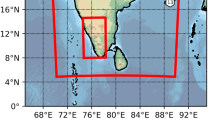Abstract
In recent decades, climate change has been of great concern due to its effect on water level and its impact on aquatic ecosystems. Urmia Lake, the largest inland wetland in Iran, has been shrinking. There is a great concern whether it will dry up like the Aral Sea. Therefore, a hydrodynamic model has been developed to simulate the condition of Urmia Lake. The model has been validated using the known annual data on precipitation, evaporation, run off, river discharges and water level which are available for the last 35 years. Different hydrological conditions regarding lake input and output data were tested and water depth was calculated using bathymetry to predict water-level fluctuations in the future. The results predict that the water level will decrease continuously. The lake will be dried up in about 10 years if very dry conditions continue in the region. The drought speed cannot be reduced and there is no potential to develop a water-usage program. Besides, the lake water depth decrease is more slightly, applying alternate wet and dry-period conditions. In some hydrological conditions there is a good potential to consider water development projects. The sensitivity analysis of different parameters indicates that the lake is highly sensitive to river discharges, which implies that the water development project plans will disturb the lake ecosystem if implemented up to 2021 and integrated watershed management plan for the lake can change the condition by regulating the dam output.







Similar content being viewed by others
References
ABNIROO (1994) Consulting engineers. Second phase preliminary studies of Shahid Kalantary Highway cross over Lake Uromiyeh. Report of Ministry of Energy. Tehran, Iran
Ahmadzadeh Kokya A, Pejman AH, Mahin Abdollahzadeh E, Ahmadzadeh Kokya B, Nazariha M (2011) Evaluation of salt effects on some thermodynamic properties of Urmia Lake Water. Int J Environ Res 5(2):343–348
Alesheikh AA, Ghorbani A, Talebzadeh A (2005) Generation the coastline map for Urmia Lake by TM and ETM + imagery. http://www.gisdevelopment.net
Altunkaynak A, Şen Z (2007) Fuzzy logic model of lake water level fluctuations in Lake Van, Turkey. Theor Appl Climat 90:227–233
Azerbaijan Regional Water Authority website (2010). http://www.agrw.ir/
Bates PD, Lane SN, Fergusen RL (2006) Computational fluid dynamics-application in environmental hydraulics. John Wiley & Sons, Ltd. USA
Blumberg AF, Mellor GL (1978) A coastal ocean numerical model, mathematical modeling of estuarine physics. In: Sundermann J, Holz KP (eds) Proceedings of an International Symposium, Hamburg, August 24–26. Springer-Verlag, Berlin, pp 203–219
Blumberg AF, Mellor GL (1987) A description of a three-dimensional coastal ocean circulation model, In: Heaps N (Ed) Three-dimensional coastal ocean models. American Geophysics.
Chen C, Liu H, Beardsley RC (2003) an unstructured grid, finite-volume, three-dimensional, primitive equations ocean model: application to coastal ocean and estuaries. J Atmospher Ocean Tech 20:159–186
Chen C, Huang H, Beardsly RC, Liu H, Xu Q, Cowles G (2007) A finite volume numerical approach for coastal ocean circulation studies: comparisons with finite difference models. J Geophys Res 112:C03018
Daemi AR (2009) The impacts of climate change on Urumie Lake: quarterly periodical. J Inst Iran Cultur Appl Res Rural Heritage Mus Guilan 8:17–22
Delavar M (2005) Analysis and proposing a model for Urmia Lake water level variations and risk analysis of the coastal region. M.Sc thesis. Tarbiat Modarres University, Tehran
Eimanfar A, Mohebbi F (2007) Urmia Lake (Northwest of Iran): a brief review, saline systems. http://www.artemiarc.ir/en/index.php?option=com_content&task=view&id=14&Itemid=1
Hashemi M (2008) Synthesis report: an independent review: the status of water resources in the Lake Uromiyeh Basin. School of Civil Engineering and Geosciences, Newcastle University, UK
Huang H, Chen C, Cowels GW, Winnant CD, Beardsley RC, Hedstorm K, Haidvogel DB (2008) FVCOM validation experiments: comparison with ROMS for three idealized barotropic test problems. J Geophys Res 113:1–14
Hubbard ME (1999) Multidimensional slope limiters for MUSCL-type finite volume schemes on unstructured grids. J Computat Phys 155:54–74
Karbassi A, Nabi Bidhendi G, Pejman AH, Bidhendi ME (2010) Environmental impacts of desalination on the ecology of Urmia Lake. J Great Lakes Res 36(3):419–424
Kelts K, Shahrabi M (1986) Holocene sedimentlogy of hypersaline Urmia Lake, northwestern Iran. Paleogeol Paleoclimatol Paleoecol 54:105–130
Kobayashi MH, Pereira JMC, Pereira JCF (1999) A conservative finite-volume second order accurate projection method on hybrid unstructured grids. J Computat Phys 150:40–75
Mohammadi MA (2004) Relation between fresh and salty water and its impact on Urmia Lake evaporation. West Azerbaijan Water Authority, Ministry of Energy, Iran
Nazaridoust AA (2006) Methodological framework, guidelines and DSS model to calculate the minimal ecosystem water requirements for wetlands: a case study of the International Wetlands in the Lake Uromiyeh Basin. Science and Research Branch, Azad Islamic University, Teharn 2006
Sivakumar MVK, Wilhite DA (2002) Drought preparedness and drought management, ICID, ERWG Conference on “Drought Mitigation and Prevention of band desertification”. Bled, Slovenia
Vaziri M (1997) Predicting Caspian Sea surface water level by ANN and ARIMA models. J Waterway Port Coas Ocean Eng 123(4):158–162
Woodbury LH, Padmanabhan G (1989) Estimating terminal lake level frequencies, ASCE. J Water Resour Plan Manag 115(3):321–337
WRI (2005) Integrated water resources management (IWRM) for Lake Uromyeh Basin. Module 1: Data Reports, Iran (PvW-02.048). West Azerbaijan Water Authority, Ministry of Energy, Iran
WWA (2005) The environmental impact assessment and study (quality and quantity) of the Development Projects in the Lake Uromiyeh Basin. The West Azerbaijan Water Authority (WWA), Ministry of Energy, Iran
Zeinoddini M, Tofighi MA, Vafaee F (2009) Evaluation of dike-type causeway impacts on the flow and salinity regimes in Urmia Lake. Iran J Great Lake Res 35:13–22
Zhaoqing Y, Tarang Kh (2008) Modeling of salt intrusion, intertidal mixing, and circulation in a Braided Estuary. J Coas Res 52(Special Issue):171–180
Author information
Authors and Affiliations
Corresponding author
Rights and permissions
About this article
Cite this article
Abbaspour, M., Javid, A.H., Mirbagheri, S.A. et al. Investigation of lake drying attributed to climate change. Int. J. Environ. Sci. Technol. 9, 257–266 (2012). https://doi.org/10.1007/s13762-012-0031-0
Received:
Revised:
Accepted:
Published:
Issue Date:
DOI: https://doi.org/10.1007/s13762-012-0031-0




